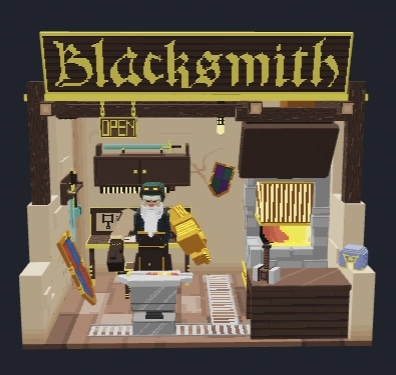🟦Assets & Equipment
The utility of any asset depends on how it is constructed in VoxEdit, what Attributes are created when it is uploaded or minted (for equipment), and how it is brought to life in Game Maker with logic.
What is an Entity?
An Entity is anything you can place in your Experience in Game Maker, including:
Blocks - solid and liquid terrain (logic may not be applied)
Assets - VoxEdit creations that can be minted and sold as NFTs, brought to life in Game Maker including characters, props, passes, and equipment. The Sandbox has provided a variety of free Basic assets in the Game Maker library that you may use in your Experiences.
Logic Assets - invisible assets with no collisions that can have logic applied like a normal asset
Presets - one or more objects with custom logic and location data saved for reuse or spawning
What are Assets?
About Assets
Assets are Entities made in VoxEdit that can be uploaded to your Workspace and minted as NFTs to sell on the Marketplace. They are used to populate Experiences in The Sandbox to create 3D interactions (physics and visual).
Equipment is a special asset that must be made with a template to work correctly.
Asset Categories
Characters - non-player characters (NPCs) such as humans, animals, robots, etc.
Props - static or interactive objects from buildings to buttons
Passes - an NFT that will grant players access to a gated Experience
Equipment - items applied to the player's avatar to change appearance or gameplay stats
Equipment can alter a player's stats when applied to the avatar. The effect depends on the Catalyst and Attribute Points applied.
Creating Assets
Visit the Asset Guide for creative considerations and recommendations to build specific asset types.
Create and Test Assets
VoxEdit: Create Assets
VoxEdit Equipment Templates
Game Maker: Test, Build Experiences
Place Assets and apply logic
Asset Guide
With VoxEdit, you can create Assets from scratch or use templates with built-in animations to save time. Visit the Asset Guide to explore design recommendations for a variety of content types including scenery, NPCs (non-player characters), 2D/3D art, and more!
🧍Asset GuideRarity & Attributes





A Catalyst is special NFT that is burned when minting an asset into an NFT to define its rarity. One Catalyst is required per NFT created. You do not need to own a Catalyst NFT to create a Draft asset to use in your own Experiences.
The more rare the Catalyst, the more Attributes Points will be available to apply to equipment assets when minting an asset as an NFT to sell or creating a Draft asset for use in your own Experiences. This is done when uploading an asset to your Workspaces.
How to Create Attributes
Attributes are created when an asset is uploaded to Workspaces for testing or use in your own Experiences. This does not require minting the asset, for example, if you plan to use your custom assets in your own Experiences. You can modify the asset details up until it is minted as an NFT.
GAME DESIGN TIP You can gradually provide players with opportunities to collect and use more powerful equipment during an Experience to reward their achievements and balance out increasingly difficult enemies presented. It makes your Experience more thrilling! This can be part of your Experience's Ramp of Difficulty and Risk & Reward design.
Assets & Game Inventory
Last updated
Was this helpful?








